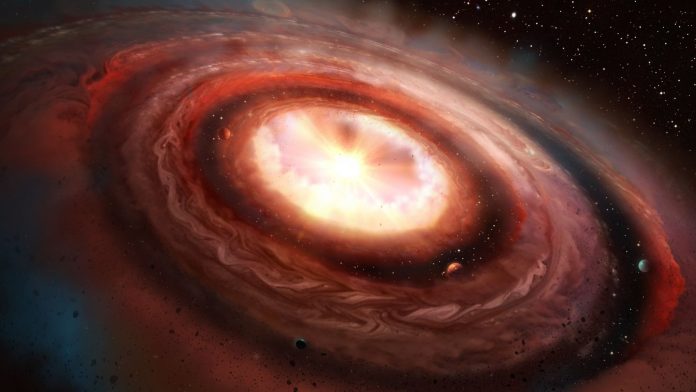
The most widely recognized explanation for planet formation is the accretion theory.
It states that small particles in a protoplanetary disk accumulate gravitationally and, over time, form larger and larger bodies called planetesimals.
Eventually, many planetesimals collide and combine to form even larger bodies. For gas giants, these become the cores that then attract massive amounts of gas over millions of years.
But the accretion theory struggles to explain gas giants that form far from their stars, or the existence of ice giants like Uranus and Neptune.
The accretion theory dates as far back as 1944 when Russian scientist Otto Schmidt proposed that rocky planets like Earth formed from ‘meteoric material.’
Another step forward happened in 1960 when English astronomer William McCrea proposed the ‘protoplanet theory,’ stating that planets form in the solar nebula.
In the decades since then, the accretion theory was refined and added to, and in modern times, astronomers have gathered more observational evidence that supported it.
However, the theory has some holes that still need plugging.
According to the theory, forming a core large enough to become a gas giant takes several million years, and protoplanetary disks dissipate too soon for that to happen.
Protoplanets also tend to migrate toward their star as they grow, and they may not gather enough mass before the star consumes them.
The accretion theory faces another problem that’s surfaced since we’ve discovered more exoplanets in other solar systems. It struggles to explain hot Jupiters and super-Earths.
Over the years, the development of streaming instability and pebble accretion has overcome some of these problems. Streaming instability explains how particles in a gas disk experience drag and accumulate into clumps, which then collapse gravitationally. Pebble accretion explains how particles from centimetres to meters in diameter experience drag and form planetesimals. Both of these have strengthened the accretion theory, but astronomers still hunger for a complete theory of planet formation.
Researchers have developed a new model that incorporates all the physical processes involved in planet formation.
Their work, which is published in the journal Astronomy and Astrophysics, is titled “Sequential giant planet formation initiated by disc substructure.”
The lead author is Tommy Chi Ho Lau, a doctoral candidate at Ludwig-Maximilians-University in München, Germany.
The new model shows that substructures in a protoplanetary disk called annular perturbations can trigger the formation of multiple gas giants in rapid succession. Critically, this model matches up with some of the most recent observations.
Planets form in unstable gas disks around stars. The researchers show how small, millimetre-sized dust particles accumulate in the disk and become trapped in the annular perturbations. The authors call these migration traps. Since they’re trapped, the particles can’t be gravitationally drawn toward the star. A lot of material from which planets form accumulates in these compact regions in the disk, which creates the conditions for rapid planet formation.
“We find rapid formation of multiple gas giants from the initial disc substructure,” the researchers write in their paper. “The migration trap near the substructure allows for the formation of cold gas giants.”
Written by Evan Gough/Universe Today.



